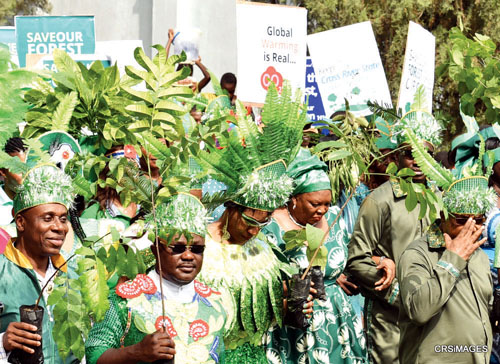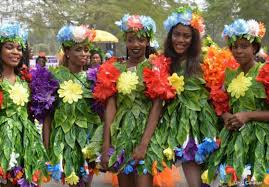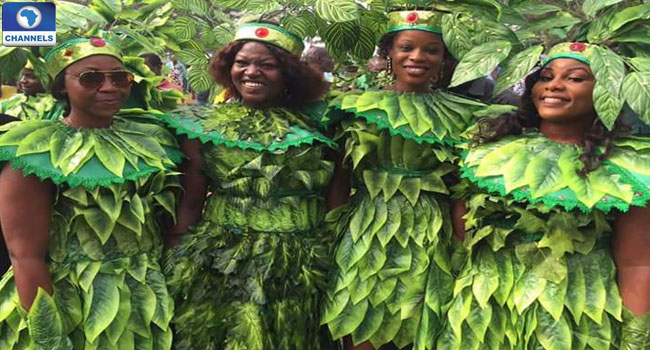BY CHIMA NWAFO
One of the problems of politicians in this part of the world is the tendency to view every aspect of development as monumentally taxing and difficult to attain, as if they have to reinvent the wheel. But one of the masters from the developed world made it clear that you don’t have to, no matter the subject or area of endeavour. All you need is to stand on the shoulders of those that have been there before you. Or as the cerebral Chinweizu put it, to say you are original today, you may have to cut off your head. But, given that Africa lags both in human and material development; an initiative such as Prof Ben Ayade’s vision of planting a million trees with a specific date of commencement is commendable. Given that his gesture is geared towards a healthier and cleaner environment, this column would not only salute him but offer necessary and informed counsel on how to achieve the desired goal.
In a recent media report, the Cross River State Governor was said to have declared July 30 of every year – beginning from this month of 2019 – as a “public holiday for the planting of one million trees in a ceremony known as Green Carnival.”
His chief press secretary, Mr. Christian Ita, who disclosed this to journalists on Wednesday July 16, in Calabar, the state capital, noted that his boss explained the rationale for specifying a day for the exercise, which is to “underscore our readiness for the REDD+ and commitment to forest conservation and management.” For the benefit of the lay public, the acronym REDD+ means Reducing Emissions from Deforestation and Forest Degradation, plus the sustainable management of forests and conservation and enhancement of forest carbon stock. Unlike most of his peers who are either indifferent to ecological issues or make unrealistic political statements about the environment, Ayade made it clear that as an agricultural state blessed with enormous land resources, that the initiative is also an essential part of the global efforts to mitigate climate change. He was confident that the Food and Agriculture Organisation (FAO) will stand by its words to “support developing countries in their REDD+ processes and in turning their political commitments, as represented in their Nationally Determined Contributions (NDCs), into action on the ground.”

The professor, who affirmed that one million trees would be planted during this year’s Green Carnival on July 30, added that the exercise, which is to take place simultaneously across the 18 local government areas of the state, was also aimed at addressing the challenge of urban deforestation.

Given that the Orbit in earlier edition had canvassed the need for the Federal Government to set aside a day to honour Oloibiri crude oil-find, to be dedicated for the promotion of environmental issues nationwide. Nigeria being a federation, the Bayelsa State government could equally come out with a date for that event to be honoured in the state, from where we can move to the federal. Governor Ayade has shown a good example in an area of great importance to all the states, the large metropolitan city-states.
In terms of planting trees to turn a desert land into well-watered arable land, the tiny but creative Republic of Israel, has excelled in that area. Given her success, it is important to note that tree planting for afforestation, is not a political exercise with empty unfulfilled pledges. Also of great interest the governor’s assurance that progamme will have a peculiar feature for the ancient and historical city of Calabar, already famous for carnivals. His words: “The Urban Green Canopy Calabar initiative would sustain Calabar as the greenest city in Nigeria and Cross River as the greenest state.”
Reading through the report, it had the typical Nigerian politicians’ touch: All text and no plans and strategies to actualize the programme, which we know should involve experts in town and country planning, geography, landscape architecture and gardening, among others.
Since only Calabar was specifically mentioned as a city, no success can be achieved with greening without landscaping, especially because it is an unplanned coastal city bedeviled by floods. This message goes to the larger urban commercial centres such as Lagos, Abuja, Kaduna, Kano, Ibadan, Aba, Onitsha, Port Harcourt, Uyo, among others.

Why exactly should we bother about tree planting when the country is wracked by poverty, insecurity, unemployment, among other social ills?
Professionals have a credible and satisfactory answer, to those who care. “Trees give off oxygen that we need to breathe. Trees reduce the amount of storm-water runoff, which reduces erosion and pollution in our waterways and may reduce the effects of flooding. Many species of wildlife depend on trees for habitat. Trees provide food, protection, and homes for many birds and mammals.” The tiny and creative nation of Israel, as in many other facets of life provides a good example of a successful campaign of tree planting through the years, as captured in the free encyclopaedia: “With over 240 million planted trees, Israel is the only country that entered the 21st century with a net gain in the number of trees. Due to massive afforestation efforts, this fact echoed in diverse campaigns. Israeli forests are the product of a major afforestation campaign by the Jewish National Fund (JNF).”

In the well-planned and aesthetically landscaped metropolitan Western cities, tree planting stands them out from the slums of Africa and other third world countries. In those countries, the history of landscape gardening, later called landscape architecture, dates back to 1800, when they were features of manor houses, royal palaces, religious complexes and government establishments. Wikipedia defines landscape architecture as follows”

Landscape architecture is a multi-disciplinary field, incorporating aspects of botany, horticulture, the fine arts, architecture, industrial design, soil sciences, environmental psychology, geography, ecology, and civil engineering. The activities of a landscape architect can range from the creation of public parks and parkways to site planning for campuses and corporate office parks, from the design of residential estates to the design of civil infrastructure and the management of large wilderness areas or reclamation of degraded landscapes such as mines or landfills. Landscape architects work on structures and external spaces with limitations toward the landscape or park aspect of the design – large or small, urban, suburban and rural, and with ‘hard’ (built) and ‘soft’ (planted) materials, while integrating ecological sustainability.
“The most valuable contribution can be made at the first stage of a project to generate ideas with technical understanding and creative flair for the design, organisation, and use of spaces. The landscape architect can conceive the overall concept and prepare the master plan, from which detailed design drawings and technical specifications are prepared. They can also review proposals to authorize and supervise contracts for the construction work. Other skills include preparing design impact assessments, conducting environmental assessments and audits, and serving as an expert witness at inquiries on land use issues.”
*Nwafo, Veteran Copy Editor/Environmental Analyst, can be reached on: [email protected].
Share your story or I
Witness Reports with us 24/7 via: SMS: +234 (0)9076248001
Whatsapp: +234(0)8072022024, Email: [email protected]
Website: www.gatmash.com
For advert placement, contact us today via email: [email protected] or call our hotlines on Tel: +234(0)8072022024, 08166622444, 09076248001






